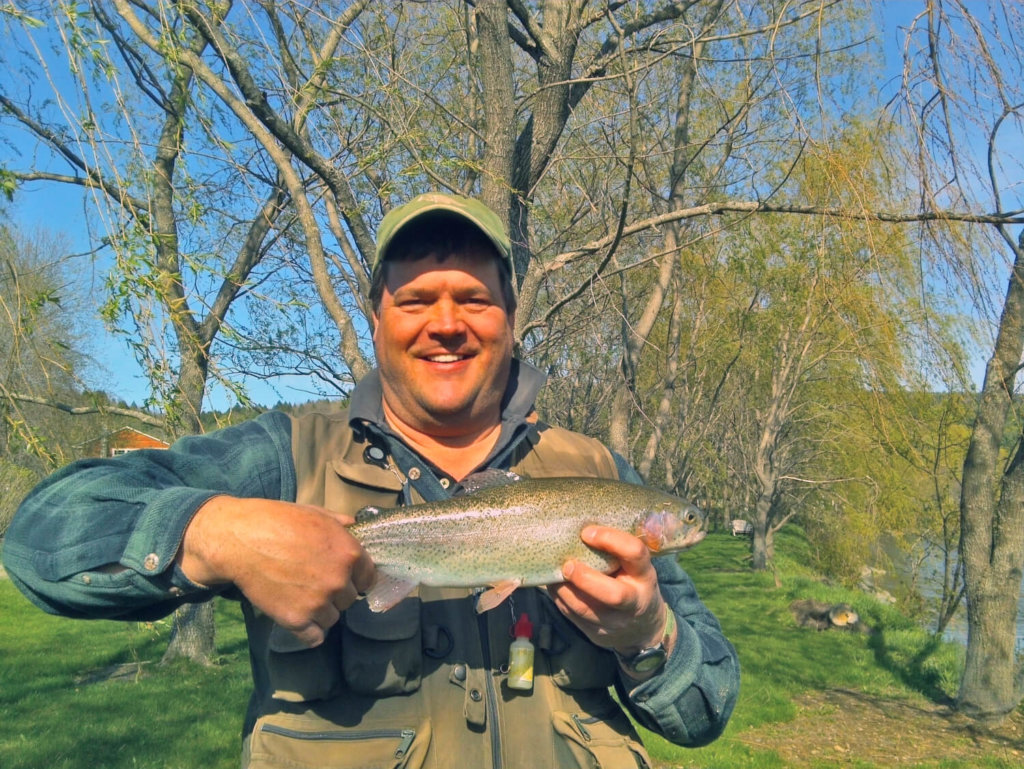When fishing with intention and discipline, who gets ‘hooked’?
One of the few things my father handed down to me was a deep abiding love of trout.

My appreciation, nay, obsession for the iridescent sheen of the rose-colored flank of a rainbow flashing in the sunlight as it leaps into the air of a hidden pool began as a simple exploration of flyfishing at an elite trout club in Berea, Ohio.
My father would hold meetings in the clubhouse with potential investors. He would send my brother, Miles, and I to figure out flyfishing techniques on the upper pools, which were stocked with behemoth brown and rainbow trout that had been fed pellets in a tightly controlled oxygen-rich environment.
I was 10 years old, and my brother was just 6. We had no instruction other than an awkward cast that heaved large flies called wooly buggers. We were given a bag lunch of sandwiches and gouda cheese from the bar in the clubhouse and soon figured out that those wooly buggers worked a lot better when we molded a small ball of the cheese onto the hook.
Before long, we had piled up a half cord of these monster rainbows when one of the gamekeepers alerted my father that his boys were draining the pond of their biggest fish and that they would be added to his tab at $3 a pound.
It was years before I learned about etymology and proper conservation concepts. I had been “sent away” to boarding school at Vermont Academy, where my educators taught us the finer points of flyfishing and how to read a stream. We picked up bugs from underneath rocks in a crystal-clear river and brought them back to the classroom in glass jars to study them.
We learned the major distinct species of mayflies, stoneflies and caddis. We studied water clarity, oxygen measurements and the difference between a freestone and a lime stream. We studied alkalinity, temperature, and phototropism. And to graduate from these classes we had to perform a proper roll cast and demonstrate how to properly load a rod based on its action — slow, medium or fast.
I did not know at the time that we were learning respect for the ecosystem and the species. Our goal was still to catch trout but now we did it with intention and discipline. That, in turn, led us to deepen our understanding and love of the sport.
Decades later, I sneak quietly into a hidden pool, using the green canopy overhead and shadows as camouflage. Having hiked miles into the headwaters of a mountain stream that feeds one of Vermont’s major rivers, I am conscious of every element of the area.
I check the rocks and examine the surface from 20 yards downstream of the pool to see what insects are hatching and which, if any, are spinning on the surface to be slurped into the vortex of a rising trout’s mouth. I check the water’s temperature and study the current to figure out where a hungry rainbow or brookie might hang out waiting for a delectable meal to float into its lane.
Trout are smart. They use as little energy as is required to feed when the water is warmer and are much more aggressive when the water is still cold. This time of year, it is still quite cold. I cautiously move upstream to stand behind a big boulder that sits just downstream of the pool. As I peek over the top of the rock, I notice a small whirlpool form just past the tail of the current. Within minutes, it happens again, but this time I catch the tip of a nose poking out of the whirlpool.
He’s feeding. Selectively. Being 63 years old, and having flyfished for over 50 years now, I have accumulated enough wisdom to identify the hatch of flies and tie on a terrifyingly accurate deceiver, my favorite, the yellow elk hair caddis with a rust-colored thorax.
But being 63 I also have accepted that I’ve had to make some adaptations to my passion. I now use 3.5x glasses to thread the hair-thin tippet through the eye of the fly. Even then it takes a few tries. Sometimes my hand begins to shake a bit and I curse Father Time for what he’s done to my body.
But I’ve learned to be disciplined in my concentration. Let me tell you that when a fish is rising in front of you, and you must maneuver a 6x tippet onto a size 20 fly, your hand will not respect that you need to be expeditious in your actions.
Finally, the tiny fly is drawn back behind my right shoulder and as the rod bends backwards, I can feel the loading of the shaft. I let the fly finish its arc and gently but forcefully thrust the line forward. The line unravels in front of me and as it completes its forward arc, the fly floats tenderly to rest on the water, just below the riffles.
I stare at the fly as it swirls a bit in the current. It floats with its wing patterns extending upward from the rusty thorax. Just as it begins to play out of the riffles, it happens. The big rainbow slurps the caddis into his mouth and in a split second recognizes his error.
With a powerful thrust of his forked tail, he jettisons into the air, his flank flashing a pink rose stripe reflected against his silvery body. This moment is what drives old men to overcome their physical obstacles and engage in the oldest game on the planet. Is it the fish or is it me that’s hooked?
The glorious opening day of trout season in Vermont begins this Saturday, April 9.
Bradley Carleton is executive director of Sacred Hunter, a non-profit that seeks to educate the public on the spiritual connection of man to nature.

